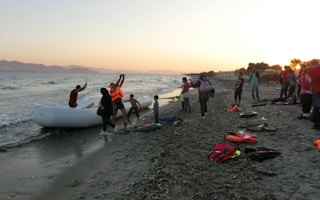They were fresh off the boat, the group of refugees I met this time last year. They had fled their homes in Syria, traveled halfway across Turkey, and placed their lives in the hands of a gang of people smugglers promising to get them to Europe. Despite all that they had endured, one of them told me, upon landing on the Greek island of Lesbos, that they had panicked only once during that perilous voyage: when their mobile phone signal disappeared.
That signal, however weak, had been the refugees’ only link to the outside world. When it vanished – when they truly had no way to contact family, friends, or anyone who could help them – they were gripped by a sense of isolation and fear more intense than they had ever experienced. It is a feeling no one should have to endure ever again.
For most people in the industrialized world – and everyone at this year’s World Economic Forum Annual Meeting in Davos – connectivity is a fact of life. We have mobile phones, tablets, and computers, all linked to superfast – and accelerating – broadband networks. Add to that an ever-increasing number of social-media platforms, and we are always in contact with one another. Information flows so freely and relentlessly, in fact, that we tend to worry more about overload than scarcity.
For refugees, life is very different. Globally, refugees are 50 per cent less likely than the general population to have an Internet-enabled phone, and 29 per cent of refugee households have no phone at all. Though 90 per cent of refugees located in urban environments live in places with 2G or 3G coverage, about a fifth of those living in rural areas have no connectivity at all.
This is a big deal. For refugees, connectivity is not a luxury, but a lifeline – one that has become all the more important at a time when sentiment in many host countries is turning against them (even as plenty of grassroots movements and communities remain eager to help). In some cases, technology can do what hostile politicians and reluctant governments will not: give refugees a chance to rebuild their lives.
Connectivity means, at the most fundamental level, being able to remain in contact with family members left behind, some of whom may still be at risk of violence or persecution. Connectivity also provides access to important and up-to-date information about new threats, such as disease outbreaks or the spread of conflict, or the availability of necessities like food and water, clothing, shelter, and health care.
In the longer term, connectivity can support online education and training that equips refugees for the workforce. It can help them find employment, and link them with legal or other crucial services. And it can enable them to communicate more easily with organizations like the United Nations Refugee Agency (UNHCR), telling us what they need most, what we’re getting right, and where we need to make changes.
In a world of unlimited data, there is little stopping us from providing refugees with this lifesaving connectivity. If we are smart about how we design digital aid systems, we will have the opportunity to broaden our partnerships to hundreds, if not thousands, of organizations worldwide that are willing to help refugees.
“
In a world of unlimited data, there is little stopping us from providing refugees with this lifesaving connectivity.
Realizing this potential requires overcoming two key challenges. First, we must figure out how to improve connectivity for refugees today. Second, we must position ourselves to use technology more effectively tomorrow.
Overcoming these challenges will require, first and foremost, that governments improve access, including by investing in the necessary digital infrastructure. It will also require contributions from the private sector, particularly telecommunications providers, which can lend their technological expertise, global reach, and spending power to help ensure access to affordable phones and computers, inexpensive data plans, and training in digital literacy.
Success on these fronts will require using microwave links, satellite dishes, unused television spectrum, drones, and balloons to improve wireless Internet access and capabilities in locations containing many refugees. Because the vast majority of today’s refugees are in developing countries, improved connectivity would carry far-reaching benefits for the host communities.
In 2014, my colleagues encountered a young Syrian man called Hany, who had fled the city of Homs with his family and found refuge in a camp in Lebanon’s Beka’a Valley. A poet, rapper, and photographer, Hany was such a force of nature that it took my colleagues a while to realize he had a serious eye condition and could see only a few inches in front of his face. His mobile phone was utterly essential. It enabled him to learn English, take his first photographs, and call for help when he needed it. That same phone rang one day with the news that the city of Regina, Canada, was to be his new home. As he put it, “my phone is my little world.”
For refugees like Hany, staying connected is not only a matter of survival; it also provides a route to self-reliance and independence, boosting their own wellbeing and enabling them to contribute to the communities that host them. Last year, the World Economic Forum launched a program called Internet For All. We must ensure that “All” includes refugees.
Filippo Grandi is the United Nations High Commissioner for Refugees.
Copyright: Project Syndicate, 2017.
www.project-syndicate.org











